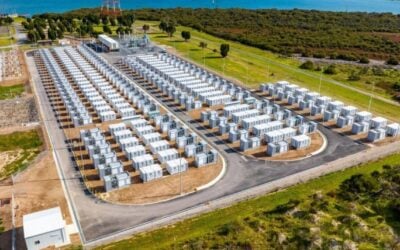As has been asserted previously by a number of indsutry commentators and experts, energy storage could “displace a significant portion of future gas-fired generation capacity”, paving the way for further integration of renewables, Lazard said in the report. Wikimedia: user: Jim Henderson.
Energy storage is already competitive in a number of mainly grid-based applications, while lithium-ion battery prices could fall by as much as 50% in the next five years, financial advisory and asset management firm Lazard has found.
Lazard, which is mostly involved in the investment banking sector, has produced annual reports comparing the levelised cost of energy (LCOE) of renewables versus conventional generation for nine years, producing its latest iteration this week. The company has also just published the first edition of its “Levelized cost of storage analysis 1.0” the use of various competing technologies within storage and also against conventional technologies.
Methodology and scope
The Lazard report selected eight storage technologies: compressed air, flow batteries, flywheels, lead acid batteries, lithium ion batteries, pumped hydro, sodium batteries and zinc batteries. It then assessed business cases for storage in both in front- and behind-the-meter scenarios, with possible five business cases considered for each. This included “stacked” business models, where more than one use case can be applied to a storage system simultaneously. US sustainability group Rocky Mountain Institute (RMI) recently produced a report which claimed up to 13 use cases could be stacked at once by some systems.
Try Premium for just $1
- Full premium access for the first month at only $1
- Converts to an annual rate after 30 days unless cancelled
- Cancel anytime during the trial period
Premium Benefits
- Expert industry analysis and interviews
- Digital access to PV Tech Power journal
- Exclusive event discounts
Or get the full Premium subscription right away
Or continue reading this article for free
As with the company’s “Levelized cost of energy analysis 9.0”, the Lazard storage study determined the cost per megawatt-hour of energy in US dollars required to give equity holders a return on their investment equal to the cost of equity capital.
Lithium-ion battery costs are predicted to make the most dramatic drop in costs. Image: A. Heddergott / Technische Universität München.
Trends
According to Lazard, the energy storage industry may be at an “inflection point”, a precursor to rapid cost decline patterns, similar to that seen in renewables over the past decade.
However, this rapid decline in costs may not be in itself enough to drive a renewable energy-powered ‘Energiewende’, the “transformative change” that Lazard said renewable energy and storage advocates are hoping for, at least not yet. The firm believes that the technologies suitable for long duration storage suitable for enabling several hours of solar time-shifting at residential rooftop PV system scale, for example, is still some way off being cost-competitive.
Nonetheless, deployment of renewable energy in great volumes will be one of the main factors exerting downward pressure on costs, Lazard found.
Cost reduction will form a “virtuous circle”, industry participants told Lazard in interviews conducted for the report. Economies of scale will drive down costs, thus enabling the deployment of more renewables, in turn creating greater demand for storage and innovation within the space.
In the meantime, as noted by a number of other commentators as diverse as the Rocky Mountain Institute and credit rating agency Moody’s, it appears to be energy storage applications that benefit the grid that are closest to competing with fossil fuels on a cost basis – or are already competitive. Moody’s also found in its report that commercial and industrial storage, including peak demand shaving, could be viable within five years.
In other words, the key appears to be applications of technologies, not the technologies themselves. Applications and business cases that require higher power capacities and system flexibility, can be more readily met with the storage technologies of today than those that require long duration of storage or high energy density.
So, for example, while a lithium-ion battery plant could be used to provide fast-acting frequency regulation, responding quickly to signals to feed short bursts of high power into the grid to balance supply and demand at as low a cost as US$211 per MWh, meaning it is close to, but not yet at competitive levels, Lazard claimed that in use for distribution services it could cost upwards of US$400 per MWh.
Moving forward, battery capital costs will decline fastest in lithium-ion, dropping by about 50% over the next five years, Lazard predicted. Flow batteries will enjoy the next steepest decline, with costs falling around 40% over that time.
Grid defection scenarios
It must also be said that Lazard appears to confuse the aims of those advocating the use of storage as a “transformational technology”. The firm repeatedly states that widespread “grid defection” i.e. going completely off-grid and becoming energy self-sufficient, even in regions where a stable grid exists, is some way off from reality and cannot be provided at a cost competitive to the grid with the technologies that exist today.
In reality, it is rare to find commentators, even within the solar industry, that consider grid defection a viable reality or even desirable logical outcome to the ongoing displacement of high emissions sources of energy. Tom Werner, CEO of SunPower told PV Tech Storage last year that he sees grid independence or defection as a “naïve” concept, while SolarCity executive Peter Rive has said that his company sees working with utilities and the grid as the most logical next step. Rive has said that placing the control of batteries in the hands of utilities and transmission and distribution system operators could give them the necessary tools to deliver the grid of the future.
Enphase CEO Paul Nahi went even further in an interview with this site, stating that in his view, the fact that well-placed solar energy systems incorporating storage could actually help the grid by playing a balancing role and by monitoring and adapting to changes in the system, has been missed by many.





